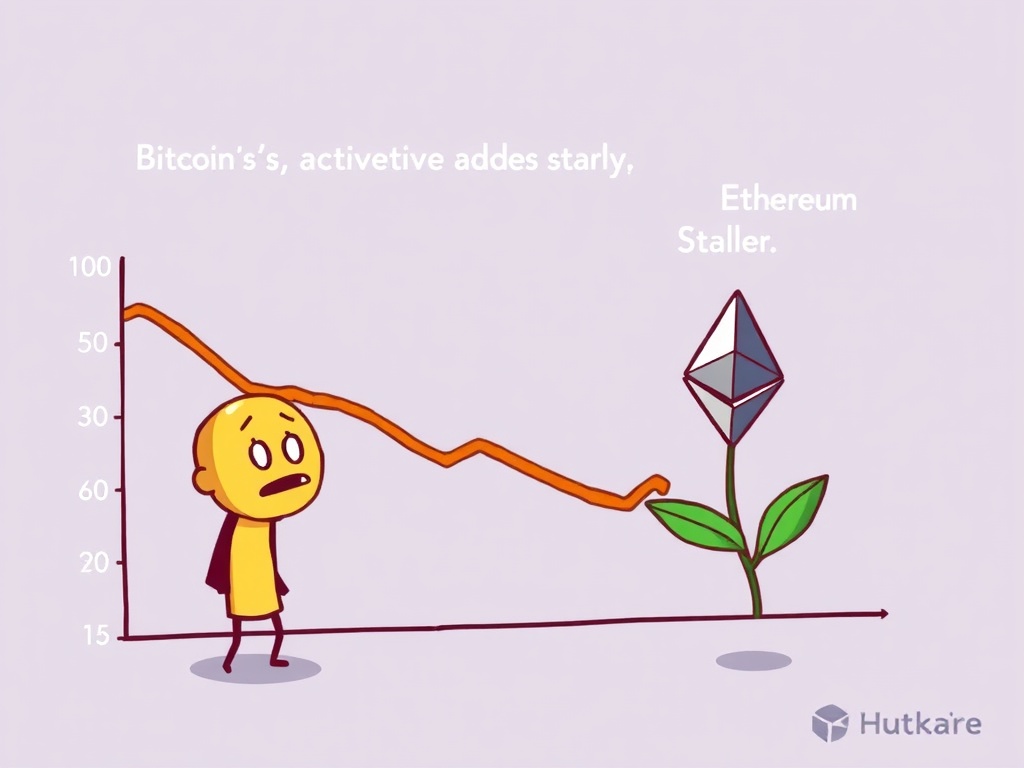BitcoinWorld

Bitcoin Daily Active Addresses: Unveiling the Alarming Drop
In the dynamic world of cryptocurrency, keeping an eye on fundamental metrics is crucial for understanding market health. Recently, a significant shift has captured the attention of analysts and investors alike: a noticeable decline in Bitcoin daily active addresses. What does this intriguing development signify for the world’s leading cryptocurrency? Is it a fleeting blip or a signal of deeper underlying trends?
What Exactly Happened to Bitcoin Daily Active Addresses?
According to data shared by Santiment on X (formerly Twitter), the landscape of Bitcoin’s on-chain activity saw a considerable change throughout July. Specifically:
- In early July, Bitcoin daily active addresses were robust, ranging between 570,000 and 800,000, indicating healthy user engagement.
- By July 31st, this number sharply declined to approximately 380,000, a significant contraction in unique addresses participating in transactions.
- In contrast, Ethereum demonstrated remarkable stability during the same period, maintaining around 511,000 active addresses, offering a compelling point of comparison.
This divergence highlights distinct user behaviors and network priorities, prompting a deeper dive into what drives such fluctuations.
Why Do Bitcoin Daily Active Addresses Matter? Understanding Network Health
When we talk about Bitcoin daily active addresses, we refer to the unique blockchain addresses active as either a sender or receiver on a given day. This metric is a vital indicator of a cryptocurrency network’s health and utility:
- Organic Adoption & Utility: High active addresses suggest genuine adoption, implying more people use Bitcoin for transactions, not just holding.
- Network Demand: Increased activity can correlate with higher demand for block space and transaction fees.
- User Engagement: Reflects community engagement; a vibrant network signifies a healthy, growing ecosystem.
- Market Sentiment: A sustained decline can precede or coincide with waning investor interest and bearish sentiment, while an increase signals renewed interest.
Understanding these dynamics is crucial for assessing Bitcoin’s fundamental strength beyond just its price chart.
Decoding the Drop: Potential Factors Behind the Decline in Bitcoin Daily Active Addresses
A significant drop in Bitcoin daily active addresses is rarely due to a single cause, but rather a confluence of market sentiment, technological shifts, and broader economic conditions. Potential reasons include:
- Bear Market Fatigue: Prolonged bear markets lead to “hodler” behavior, reducing daily on-chain transactions as users wait out downturns. Speculative activity also wanes.
- Consolidation of Holdings: Large holders may consolidate Bitcoin across fewer addresses, especially when moving to secure, custodial solutions.
- Shift to Layer-2 Solutions: As networks like the Lightning Network mature, more transactions occur off the main blockchain, not reflected in base-layer active addresses.
- Exchange Activity & User Onboarding: Changes in exchange wallet management, rebalancing, or reduced high-frequency trading can impact numbers. Fewer new users or less active existing users also contribute.
- Seasonal & Macro Factors: Crypto markets experience seasonal dips. Broader macroeconomic concerns, regulatory uncertainty, or lack of positive news can slow network engagement.
Consider these factors holistically rather than jumping to conclusions based on a single metric.
How Does Ethereum’s Stability Contrast with Bitcoin Daily Active Addresses?
The resilience of Ethereum’s active addresses, maintaining around 511,000 while Bitcoin daily active addresses saw a steep decline, provides a compelling contrast. This divergence can be attributed to several key differences in their ecosystems and primary use cases:
- Diverse Ecosystem & Utility: Ethereum’s strength lies in its robust dApp ecosystem (DeFi, NFTs, Web3), driving consistent transaction volume. Bitcoin primarily serves as a store of value.
- Smart Contract Functionality: Ethereum’s smart contracts allow complex interactions beyond simple transfers (lending, staking, gaming), boosting active address counts.
- Developer Activity: High developer activity on Ethereum leads to continuous innovation, attracting and retaining users.
- Staking & DeFi Participation: Ethereum 2.0 and liquid staking incentivize long-term holding and DeFi participation, contributing to a stable user base.
This comparison shows that while both are leading cryptocurrencies, their utility and user engagement models lead to different on-chain behavior during market fluctuations.
Table: Bitcoin vs. Ethereum Active Address Trends (July)
| Metric | Bitcoin (BTC) | Ethereum (ETH) |
|---|---|---|
| Active Addresses (Early July) | 570,000 – 800,000 | ~511,000 (stable) |
| Active Addresses (July 31st) | ~380,000 | ~511,000 (stable) |
| Trend in July | Sharp Decline | Consistent Stability |
| Primary Utility Focus | Store of Value, P2P Cash | Smart Contracts, dApps, DeFi, NFTs |
Navigating the Volatility: Actionable Insights for Investors Amidst Changing Bitcoin Daily Active Addresses
For investors, a decline in Bitcoin daily active addresses can be a cause for concern, but it’s crucial to approach such data with a balanced perspective. Here are some actionable insights:
- Diversify Metrics: Don’t panic. Look beyond active addresses to transaction volume, miner revenue, and long-term holder behavior for a holistic view.
- Focus on Long-Term Fundamentals: Bitcoin’s core value proposition as a decentralized, scarce digital asset remains. Short-term fluctuations don’t negate its long-term potential, especially with Layer-2 adoption.
- Consider Macroeconomic Context: Global economic conditions, inflation, interest rates, and geopolitical events influence investor sentiment and on-chain activity.
- Evaluate Layer-2 Growth: Monitor the Lightning Network’s growth. More off-chain transactions indicate network efficiency, even if base-layer counts are impacted.
- Stay Informed & Skeptical: Verify data sources and understand metric methodologies.
Market intelligence should inform, not dictate, your strategy. Patience and research are paramount.
Conclusion: What’s Next for Bitcoin’s Network?
The recent drop in Bitcoin daily active addresses to 380,000, as highlighted by Santiment, reminds us of the crypto market’s dynamic nature. While this decline might signal reduced network engagement, a deeper analysis reveals a complex interplay of market cycles, investor behavior, Layer-2 maturation, and the distinct utility of blockchains like Ethereum.
Evaluating Bitcoin’s health requires a holistic view, integrating various on-chain metrics, market sentiment, and broader macroeconomic trends. This shift isn’t necessarily a doomsday scenario but an invitation for a more nuanced perspective on digital assets.
Frequently Asked Questions (FAQs)
What are Bitcoin daily active addresses?
Bitcoin daily active addresses refer to the number of unique blockchain addresses that were active as either a sender or a receiver of Bitcoin on a given day.
Why did Bitcoin’s active addresses drop in July?
The drop in July could be attributed to a combination of factors including bear market fatigue, consolidation of holdings by large entities, increased use of Layer-2 solutions like the Lightning Network, and general macroeconomic conditions affecting investor sentiment.
How does Ethereum’s active address count compare to Bitcoin’s?
During July, Ethereum maintained a more stable active address count of around 511,000, contrasting with Bitcoin’s sharp decline. This is largely due to Ethereum’s diverse ecosystem of dApps, DeFi, NFTs, and smart contract functionality.
Does a drop in active addresses mean Bitcoin is failing?
Not necessarily. While a decline can indicate reduced short-term engagement, it doesn’t automatically mean failure. It’s crucial to consider other on-chain metrics and broader market trends for a complete picture.
What other metrics should I look at to assess Bitcoin’s health?
Beyond active addresses, consider transaction volume, miner revenue, exchange inflows/outflows, long-term holder behavior, and the growth of Layer-2 solutions to gain a more comprehensive understanding of Bitcoin’s network health.
How do Layer-2 solutions impact active address counts?
Layer-2 solutions like the Lightning Network handle transactions off the main blockchain. While this improves scalability and reduces fees, these off-chain transactions are not typically counted in the base-layer’s daily active addresses, potentially leading to a lower reported number even if overall activity is high.
Share Your Insights!
Found this analysis insightful? Share this article with your network on social media and spark a conversation about the evolving landscape of Bitcoin daily active addresses and what it means for the future of crypto!
To learn more about the latest crypto market trends, explore our article on key developments shaping Bitcoin price action.
This post Bitcoin Daily Active Addresses: Unveiling the Alarming Drop first appeared on BitcoinWorld and is written by Editorial Team





